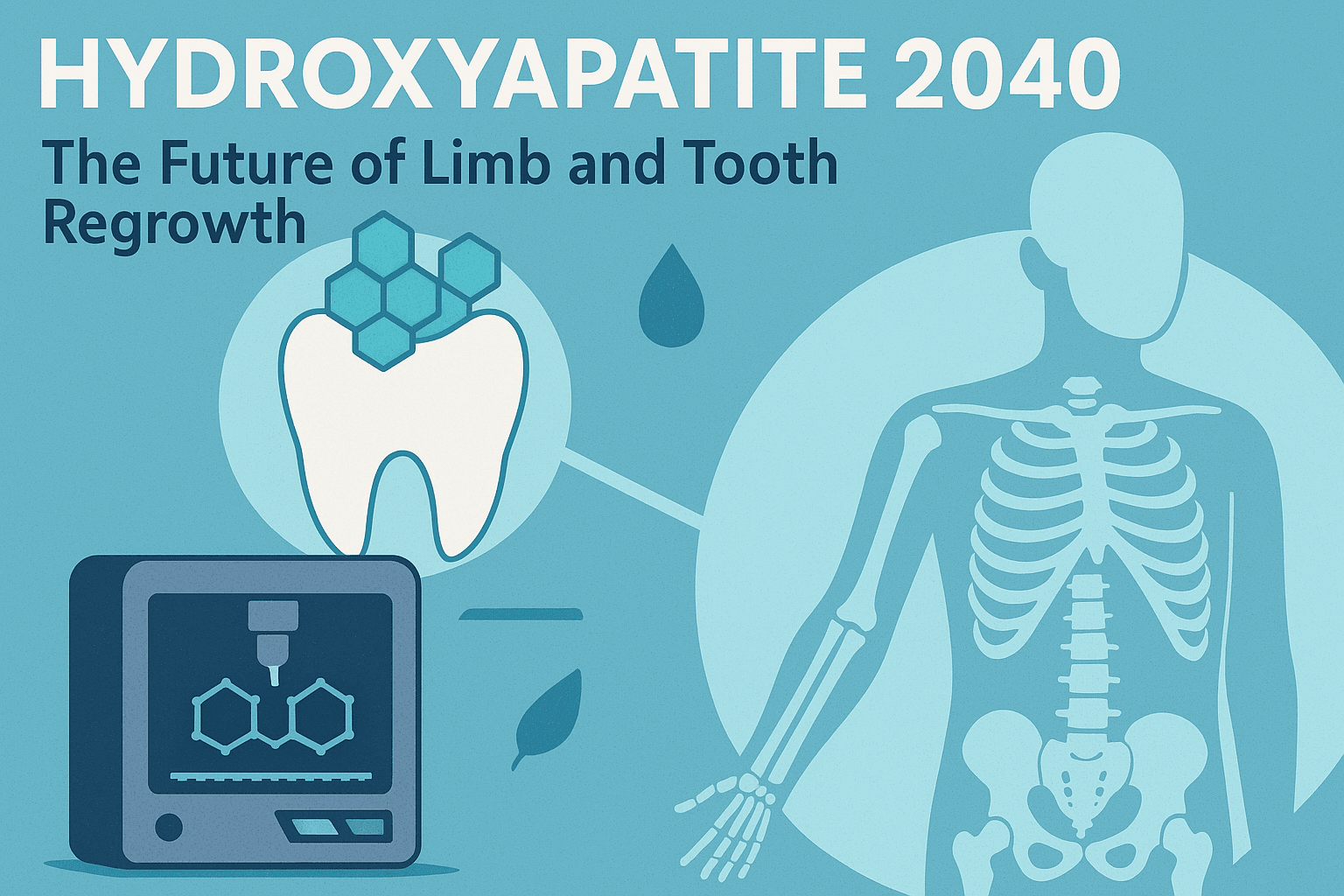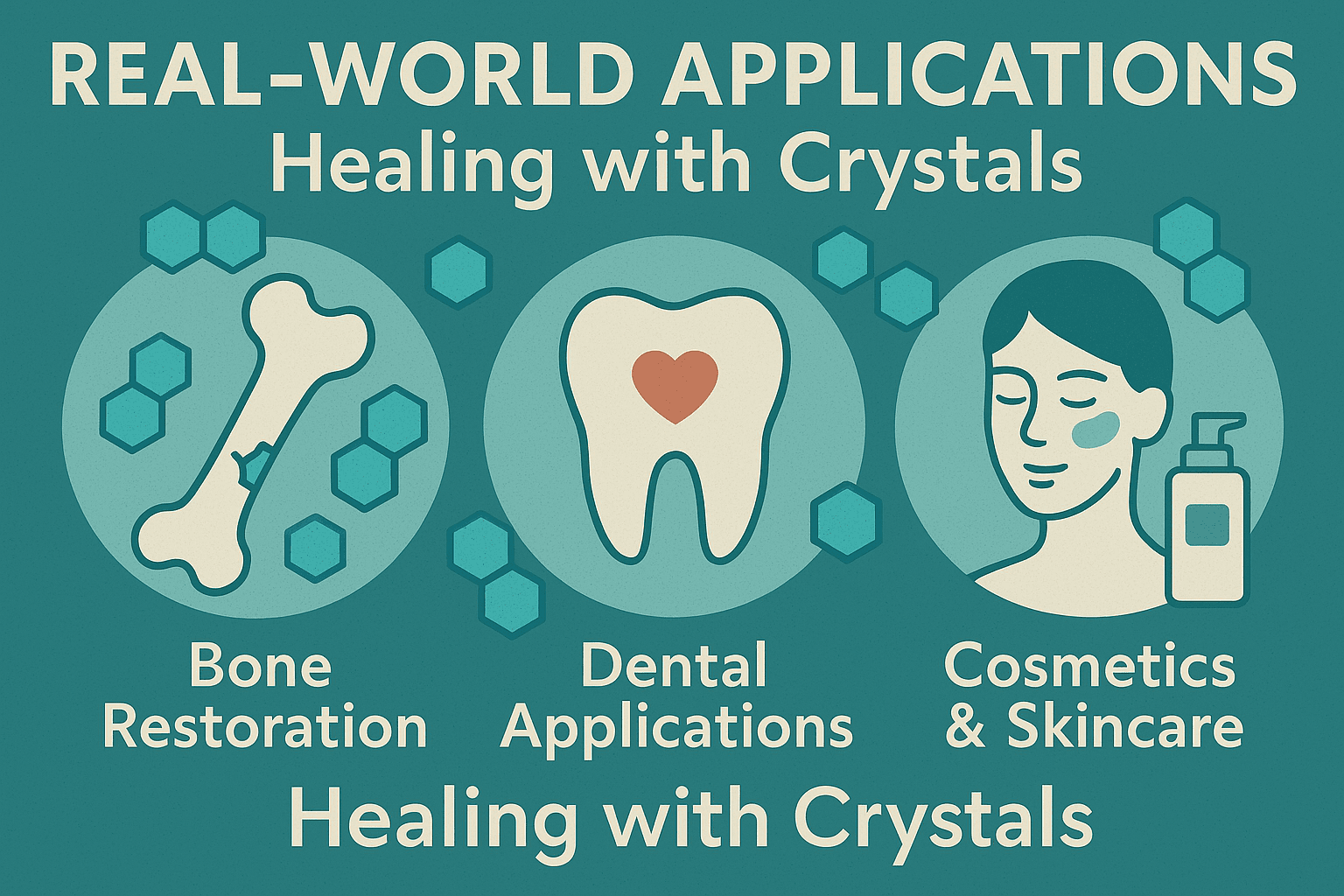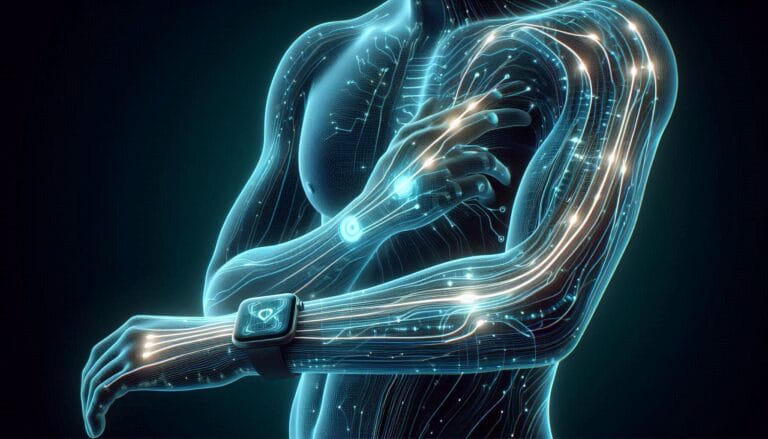📚 Introduction: The Hidden Healing Power of Hydroxyapatite
Imagine being able to regrow your bones—not with artificial implants or complex surgeries, but through a natural, crystal-like substance that’s already part of your body. This isn’t a concept from futuristic fiction, but rather a real-world breakthrough driven by hydroxyapatite (HA) . It’s a mineral found in our bones and teeth, and it holds the key to revolutionizing how we treat bone loss, dental issues, and even regeneration in medical fields.
Hydroxyapatite has been used for years in bone repair and dental treatments—it’s the material behind everything from toothpaste to bone grafts. But now, scientists are exploring how this calcium-rich compound could regrow jawbones and repair skeletal defects, offering an alternative to traditional bone reconstruction methods. The potential doesn’t stop at fixing broken bones; it could lead to innovative healing technologies that integrate bioengineering and regenerative medicine in ways that were previously unimaginable.

As we dive deeper, consider this: what if hydroxyapatite could be paired with advanced technology to regenerate not just bones but other tissues—maybe even your joints, spinal discs, or organ tissues? The fusion of natural minerals with cutting-edge healing tech may seem like science fiction today, but it’s quickly becoming a reality. Could HA be the foundation for the next generation of biomedical advancements that don’t just heal the body but regenerate it at a cellular level? This isn’t far off—the future of bone healing may already be in your bones.
In the following sections, we’ll explore how hydroxyapatite is evolving from its traditional use in bone repair and oral care to a game-changing healing technology with the power to reshape medicine itself. Natural mineral meets future-forward tech in a new era of healthcare innovation.
What Is Hydroxyapatite? The Bone and Tooth Crystal
Hydroxyapatite is a naturally occurring mineral that plays a vital role in the structure of our bones and teeth. Chemically, it’s a form of calcium phosphate, with the formula Ca₅(PO₄)₃(OH). This formula reveals its core components: calcium (Ca), phosphate (PO₄), and hydroxyl (OH), elements that give HA crystals its unique properties, including strength and durability.
The presence of HA in our body is critical. It forms the hard, mineralized matrix of bones and teeth, providing them with the rigidity needed for function and structure. Tooth enamel owes its remarkable hardness and decay resistance to its main component—crystalline hydroxyapatite, a naturally occurring mineral that forms a tough, protective shell.
HA is biocompatible, meaning it doesn’t trigger harmful reactions when introduced into the body. It’s also bioactive, meaning it can interact with living tissues to promote healing and regeneration. This is why HA crystals is so widely used in medical treatments, particularly in bone grafts and dental implants. Its ability to bond with natural bone tissue makes it an ideal material for regenerative medicine, allowing it to stimulate bone growth and repair damaged tissues.
HA’s role extends beyond just structural support. It’s increasingly becoming a game-changing tool in biotechnology for bone healing and tooth regeneration, and may soon be used to regenerate tissues far beyond bones and teeth.
Real-World Applications: Healing with Crystals
Hydroxyapatite is a versatile material that has found applications across several fields, particularly in medicine, dentistry, and cosmetics. Its natural, bioactive properties make it an ideal material for healing and restoration, offering biocompatibility and promoting tissue regeneration. Below are some of the prominent uses of HA in real-world applications.
🦴 Bone Restoration
One of the most well-established applications of hydroxyapatite is in bone restoration. HA crystals natural presence in bones makes it a perfect match for bone grafting and orthopedic implants. In bone grafts, it is used as a scaffold material to help regenerate bone tissue. It accelerates healing by providing a structure onto which bone cells can attach, grow, and mature. HA’s bioactivity means that it not only supports the structural repair but also stimulates osteogenesis (bone formation), leading to quicker and more robust recovery.
HA is also used in orthopedic implants to promote better integration with surrounding bone tissues. The material encourages the growth of new bone around the implant, reducing the risk of implant rejection and improving long-term success rates in surgeries like hip and knee replacements.

🦷 Dental Applications
In the dental world, HA is gaining significant traction due to its ability to restore and strengthen tooth enamel. It is widely used in dental implants, as it encourages osseointegration (the process by which the implant fuses with the bone). Hydroxyapatite-coated implants help improve the stability and longevity of dental implants, reducing the risk of complications post-surgery.
Hydroxyapatite also plays a crucial role in root canal therapy. When used as a coating, it helps prevent bacterial infiltration and enhances the healing process of the tooth root. It is also present in remineralizing toothpastes, where it rebuilds and strengthens enamel by remineralizing weakened or demineralized areas. HA is fluoride-free, making it a safer, natural alternative to traditional fluoride treatments. It works by filling microscopic holes in enamel and protecting teeth from acid attacks, offering a holistic approach to dental care.
🧴 Cosmetics & Skincare
Beyond its applications in dental and bone health, it is also making its way into cosmetics and skincare products. It is found in sensitive toothpaste, where its gentle remineralizing effect helps rebuild enamel without causing irritation. In skincare, bioactive hydroxyapatite creams are emerging as a promising ingredient for their ability to support skin regeneration and restore tissue health.
It’s ability to stimulate regeneration and heal damaged tissue makes it a perfect candidate for bioactive skincare treatments. Some emerging cosmetic formulations utilize hydroxyapatite’s properties to support skin cell regeneration, reduce inflammation, and even help heal small skin wounds or irritations.
Hydroxyapatite’s natural, regenerative properties are harnessed in a wide range of medical, dental, and cosmetic applications. Whether in bone grafts, dental implants, or skincare, this remarkable crystal is changing the way we approach healing and restoration, offering biocompatible solutions that promote healthier tissues and faster recovery. As research continues, HA may find even broader uses in regenerative medicine, making it a key component in the future of healing technologies.
The Science Behind the Crystal: How It Works
Hydroxyapatite (HA) is a naturally occurring calcium phosphate mineral that plays a pivotal role in the structure and function of bones and teeth. Its unique crystal structure makes it an ideal material for bone tissue engineering and regenerative medicine. The mineral’s chemical formula, Ca₅(PO₄)₃(OH), means it consists of calcium, phosphate, and hydroxide ions, mimicking the inorganic component of natural bone.
Crystal Structure and Bone Binding
Hydroxyapatite crystals are hexagonal in shape, and their precise structure allows them to bond easily with natural bone tissue. This crystallization enables strong osteoconductivity, meaning that it supports the growth of new bone cells. The interlocking structure of HA crystals integrates seamlessly with the body’s bone matrix, making it an ideal material for bone grafts and implants. By promoting the attachment of bone-forming cells (osteoblasts), HA facilitates the regeneration of damaged bone and speeds up healing.
Cellular Communication and Regeneration
Beyond structural support, HA crystals play a key role in cellular signaling. They interact with cells, especially osteoblasts, to regulate bone regeneration and osteogenesis. When the body experiences bone injury or bone loss, hydroxyapatite’s biocompatibility allows it to guide cells toward regeneration pathways. The crystals stimulate cell migration, differentiation, and the formation of new bone tissue. Studies have shown that hydroxyapatite-coated scaffolds not only accelerate healing but also improve bone formation quality.
Clinical Studies
Several studies and clinical trials have demonstrated the efficacy of HA in bone regeneration. In a 2017 study, HA bone grafts were shown to significantly improve the healing rate in patients with fractures and bone defects. Furthermore, hydroxyapatite-coated dental implants have been used successfully to promote osseointegration, reducing the risk of implant failure. Researchers are also investigating its use in bone tissue engineering to develop more effective treatments for osteoporosis and bone degeneration.
Hydroxyapatite 2040 – The Future We’re Building
The possibilities of hydroxyapatite extend far beyond the applications we know today. As research progresses, the material’s regenerative potential will likely revolutionize multiple fields, from bone healing to brain enhancement. Imagine a future where hydroxyapatite doesn’t just heal bone but becomes part of high-tech, bio-integrated systems designed to enhance human capabilities. By 2040, the landscape of regenerative medicine could look profoundly different.
🧠 Cognitive Enhancement: Neuro-Integrated Hydroxyapatite Chips for Memory Repair
One of the most groundbreaking developments could be the integration of hydroxyapatite chips into neurotechnology. By 2040, brain implants crafted from it could potentially reconnect damaged neural circuits and help recover lost memories. Much like the way it interacts with bone, this material could serve as a scaffold for neuroregeneration. By promoting cellular healing in neural tissue, hydroxyapatite chips could offer a way to combat degenerative diseases like Alzheimer’s or even enhance memory retention in healthy individuals. This idea marks the beginning of an entirely new era in boosting human cognition.
🦿 Limb Regeneration: Smart Bone Scaffolds that Regrow Tissue
Another exciting future application lies in limb regeneration. By 2040, hydroxyapatite scaffolds could evolve into smart structures capable of stimulating bone and muscle growth. These bone scaffolds, equipped with sensors and bioactive molecules, would be implanted in individuals with limb loss or severe bone damage. The scaffold would provide both structural support and actively guide the regrowth of bone and soft tissue. This application could potentially eliminate the need for prosthetics, offering a more natural and complete restoration of function.
🦾 Implantable Sensors: Real-Time Health Monitoring from Inside Your Bones
Hydroxyapatite’s future uses may even include implantable sensors capable of monitoring health markers in real-time. Imagine small, bio-integrated devices built into bones, continuously transmitting data about bone density, blood circulation, or even infection indicators. These smart implants would provide invaluable information, helping doctors detect health issues long before symptoms appear. This type of continuous health monitoring could be especially useful for elderly patients or those with chronic bone conditions, offering early warnings for diseases like osteoporosis.
🧬 Bone Bio-Printers: 3D Printing Live Bones Using Synthetic Hydroxyapatite
The bioprinting of bones could also take a giant leap forward by 2040. 3D printing technologies that use synthetic hydroxyapatite may allow doctors to print bones on demand—whether for grafting in surgery or creating entire limb replacements. These bioprinted bones would be made using a combination of HA and living cells, allowing them to be implanted directly into the body and fuse seamlessly with natural bone tissue. This approach could redefine regenerative medicine, opening doors to personalized bone therapies and eliminating the need for donors or artificial implants.
In 2040, hydroxyapatite could very well be at the core of human augmentation. Whether it’s used in memory enhancement, limb regeneration, or health monitoring, this natural bone crystal could bridge the gap between biology and technology, healing and enhancement. As we look to the future, it’s clear that the potential of HA goes far beyond simple bone repair—it may become the building block of a new era in biomedical innovation.
Challenges and Limitations
While hydroxyapatite (HA) holds immense promise in medicine and dentistry, there are several challenges that need to be addressed for widespread use. One of the key issues is the limited success of limb regeneration using HA-based scaffolds. While bone healing has shown significant improvements with HA, fully regenerating complex tissues like muscle and nerves alongside bone remains a significant hurdle. Clinical trials have yet to deliver large-scale success in functional limb regeneration, and more research is needed before this technology can be fully realized.
Another barrier is the cost of medical-grade hydroxyapatite. High-quality HA used in bone grafts, implants, and other medical procedures can be expensive to produce, which limits its accessibility, especially in low-resource settings. Moreover, the high cost of HA-based treatments frequently puts them beyond the reach of most patients.
Lastly, regulatory hurdles present challenges, especially for advanced HA implants. As HA is still evolving in its application, particularly for cutting-edge uses like neuro-integrated implants and bone bio-printing, regulatory bodies must approve these new uses, ensuring safety without stifling innovation. Safety testing, clinical trials, and compliance with medical device standards are necessary steps before widespread adoption.
Conclusion: A Crystal with a Future
Hydroxyapatite is a remarkable material with tremendous potential in fields ranging from bone regeneration to cosmetic applications. Its biocompatibility, bioactivity, and versatility have already led to successful medical implants, dental restorations, and even new cosmetic products. While there are challenges to overcome—particularly in large-scale limb regeneration and cost barriers—the future of hydroxyapatite looks incredibly promising. With advances in biomedical research, it could soon help revolutionize the way we approach healing, regeneration, and personalized medicine.
As we continue to explore its potential, it’s exciting to imagine a world where healing crystals like HA crystals not only restore bone but also help regrow tissue and heal our bodies in ways we never thought possible. The question remains: Would you trust a crystal to heal your bones? The future of regenerative medicine might just be crystal clear.
To further enrich your understanding of cutting-edge technologies that are shaping the future of medicine, health, and human evolution, check out these related articles:
🧠 Neurograins: Wireless Brain Chips and the Rise of Collective Human Intelligence – Explore how wireless brain chips like Neurograins are setting the stage for a new era of collective intelligence, with potential implications for everything from neurotechnology to brain-computer interfaces.
🔬 Neural Dust and the Smart Home Revolution – Learn about neural dust and how these tiny wireless sensors could connect your brain to your smart home, revolutionizing the way we interact with our surroundings and our personal health.
🧘 AI Therapists: Rise of AI in Mental Health – Delve into how AI therapists are being integrated into mental health care, providing accessible solutions for mental wellness through technologies like emotion AI and virtual therapy.
🧬 CRISPR and the Genetic Future of Human Evolution – Discover how CRISPR technology is unlocking the potential to rewrite human genetics, offering the possibility of eliminating diseases, enhancing human traits, and shaping the future of evolution.






